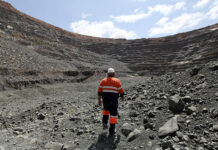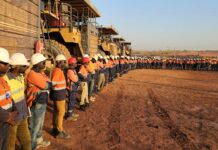
[miningmx.com] – THE average smart phone contains 16 grams of copper. There’s also silver, gold, palladium and platinum, ceramic magnetite switches containing rare earths. Then there’s indium, titanium dioxide and indium tin oxide. Feeling suitably edified?
It seems strange that given the multiple uses to which mining products are put – mobile phones among them – and in a financial community where 30% of the JSE’s listed stocks are involved in the extractive business, that the country’s Chamber of Mines is holding seminars reminding us of the importance of the sector.
Yet that’s what the chamber has been doing. In a presentation to the portfolio committee on mineral resources last year, the chamber’s voluble head of economics and strategy, Roger Baxter, spent no less than seven of 30 slides explaining the importance of mining to the South African economy.
The fact of the matter is the chamber believes the sector is regularly beaten up by the South African government and unions. Hence the provenance of the Mining Industry Growth Development and Employment Task Team (MIGDETT) in 2008, an organisation aimed at creating a forum whereby industry, the government, and labour could, essentially, ‘find each other’.
In a presentation to analysts and media last month, Baxter said discussions at MIGDETT regarding union relationships and regulatory concerns about the mining sector were robust, but in the main, successful. One wonders, however.
If MIGDETT was supposed to leave the South African government better informed of the pressures in the mining sector, that knowledge was woefully absent when mines minister Susan Shabangu responded to the proposed restructuring of Anglo American Platinum’s mines by threatening to withdraw its mining permits.
Subsequent statements, by no less than ANC general-secretary, Gwede Mantashe, raised the hackles of local and international investors after he accused Anglo American of ‘stealing’ from South Africa; it had listed in London despite mining South African minerals. Four years of MIGDETT engagement with the government seemed sadly lacking in that instance.
In his presentation in March, Baxter was again at pains to point out the seminal importance of the mining sector. The statistics are familiar ones: mining comprises 19% of South Africa’s GDP, comprises 50% of exports, provides 1.3 million jobs and 17.2% of corporate tax.
It also consumes 94% of South Africa’s electricity demand which becomes an important worry because it’s the mining sector imperiled again as Eskom struggles with a wafer-thin 1.5% reserve margin.
Every 1% increase in the electricity tariff is an extra R100m in costs to the sector. Therefore Nersa approved a R900m per year cost increase, equal to R4.5bn over five years, when it backed a 9% tariff increase for Eskom.
But Baxter was also decidedly upbeat about future negotiations with the government. As one of the lead negotiators for the mining sector, he is paid to look positively on the future which is why he told media and analysts that government’s resolutions at Mangaung had the in-principle support of the industry, and that mining legislative reforms were “in line with international best practice’.
The fact of the matter, however, is that South Africa’s economy needs mining more than ever.
In a later interview with Miningmx, Baxter said too much of the economy was being driven by the non-tradeable sector; that is, consumers with access to credit. But as Stanlib economist Kevin Lings observed in what may become a famous comment, that South Africa’s economy has to be driven more than just shopping.
“South Africa is at a cross-roads,’ says Baxter. “Tradeable export sectors (like mining) are as important in balancing the country’s growth profile. Apart from the fact that is creates skilled and semi-skilled jobs and therefore balances the labour market, it also creates export revenues.
“This is revenue that can be used to service the current account deficit (somewhere around 6% of GDP presently) and makes economic growth more predictable,’ he says.
In the last 10 years, the mining sector has been negatively affected by exogenous forces: Eskom power deficits, restrictions on freight and even the damaging nationalisation debate were a function of the government’s planning or politicking rather than fundamental mining industry oversights.
Even the labour relations problems in the platinum sector last year were exacerbated by a national fever; service delivery protests didn’t start in the informal settlements of Rustenburg. “There have been a set of complex issues that have weighed on the sector stopping it from growing quicker,’ says Baxter.
New headwinds approach. A tax review, which includes the mining sector, is due later this year while the likelihood of a carbon tax hoves into view. Given the lack of development in respect of nuclear power, and the costs of developing wind and solar power would suggest coal-fired power needs supporting, not discouraged.
Talking of wind power, and returning to another of Baxters slides, even wind turbines need mining as they contain 335 tonnes of steel (per turbine), 4.7t of copper and 1,200t of reinforced concrete.










